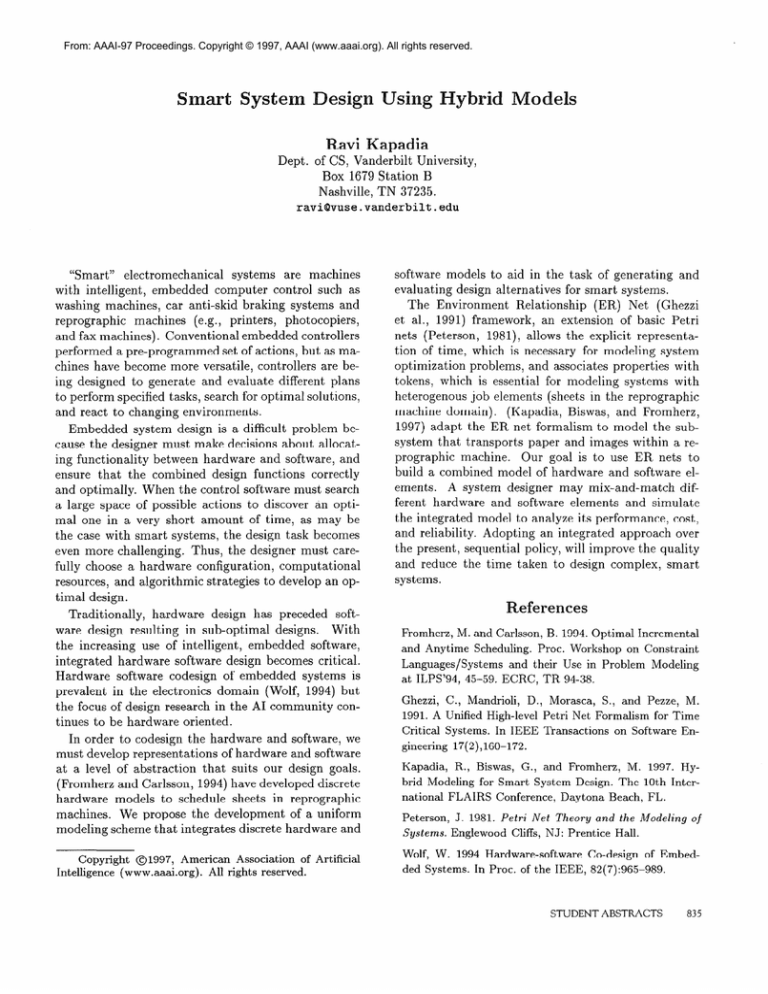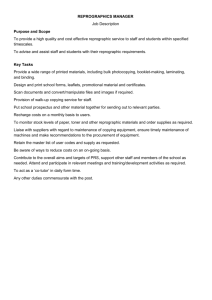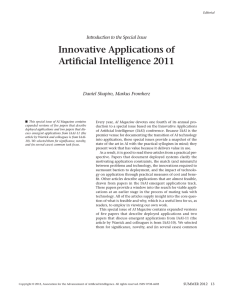
From: AAAI-97 Proceedings. Copyright © 1997, AAAI (www.aaai.org). All rights reserved.
Dept.
apadia
EbVi
of CS, Vanderbilt University,
Box 1679 Station B
Nashville, TN 37235.
raviQvuse.vanderbilt.edu
“Smart”
electromechanical
systems
are machines
with intelligent,
embedded computer control such as
software models to aid in the task of generating
evaluating design alternatives for smart systems.
washing machines, car anti-skid braking systems and
reprographic
machines
(e.g., printers,
photocopiers,
and fax machines).
Conventional embedded controllers
performed a pre-programmed
set of actions, but as machines have become more versatile, controllers are being designed to generate and evaluate different plans
to perform specified tasks, search for optimal solutions,
and react to changing environments.
The Environment
Relationship
(ER) Net (Ghezzi
et al., 1991) framework,
an extension
of basic Petri
nets (Peterson,
1981), allows the explicit representation of time, which is necessary for modeling system
optimization
problems, and associates properties with
tokens, which is essential for modeling systems with
heterogenous job elements (sheets in the reprographic
machine domain).
(Kapadia,
Biswas, and Fromherz,
1997) adapt the ER net formalism to model the subsystem that transports
paper and images within a reprographic machine.
Our goal is to use ER nets to
build a combined model of hardware and software elements.
A system designer may mix-and-match
different hardware and software elements and simulate
the integrated model to analyze its performance,
cost,
and reliability.
Adopting an integrated approach over
the present, sequential policy, will improve the quality
Embedded system design is a difficult problem because the designer must make decisions about allocating functionality
between hardware and software, and
ensure that the combined design functions correctly
and optimally. When the control software must search
a large space of possible actions to discover an optimal one in a very short amount of time, as may be
the case with smart systems, the design task becomes
even more challenging.
Thus, the designer must carefully choose a hardware configuration,
computational
resources, and algorithmic strategies to develop an opt imal design.
Traditionally,
hardware design has preceded software design resulting in sub-optimal
designs.
With
the increasing use of intelligent,
embedded software,
integrated hardware software design becomes critical.
Hardware software codesign of embedded systems is
prevalent in the electronics
domain (Wolf, 1994) but
the focus of design research in the AI community continues to be hardware oriented.
In order to codesign the hardware and software, we
must develop representations
of hardware and software
at a level of abstraction
that suits our design goals.
(Fromherz and Carlsson, 1994) have developed discrete
hardware models to schedule sheets in reprographic
machines.
We propose the development of a uniform
modeling scheme that integrates discrete hardware and
Copyright
01997,
American
Association
of Artificial
Intelligence
(www.aaai.org).
All rights reserved.
and reduce
systems.
the time
taken
to design
complex,
and
smart
eferences
Fromherz,
M. and Carlsson,
and Anytime
Scheduling.
Languages/Systems
and their
at ILPS’94,
45-59.
Ghezzi,
Mandrioli,
1991.
C.,
A Unified
Critical
ECRC,
D.,
17( 2), 160-172.
Kapadia,
R.,
Biswas,
brid Modeling
national
Peterson,
Systems.
Wolf,
W.
G.,
for Smart
FLAIRS
3. 1981. Petri
1994
ded Systems.
Use in Problem
Morasca,
Modeling
Pezze,
and
Fromherz,
Design.
Net
Daytona
Theory
Beach,
1997.
En-
Hy-
10th InterFL.
and the Modeling
Cliffs, NJ: Prentice
of the IEEE,
M.
The
M.
for Time
on Software
System
Hardware-software
In Proc.
S., and
Transactions
Conference,
Englewood
Incremental
on Constraint
Petri Net Formalism
In IEEE
gineering
Workshop
TR 94-38.
High-level
Systems.
B. 1994. Optimal
Proc.
of
Hall.
Co-design
of Embed-
82(7):965-989.
STUDENT ABSTRACTS
835






